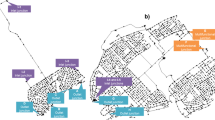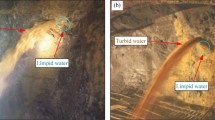Abstract
Experiments are conducted to reveal the electrical characteristics of a pulsed discharge in saltwater. To check the influence of the electrode material on discharge, we used stainless steel, red copper, and W–Cu alloy (the content of tungsten is 80%) in our experiment. As a result, four different types of discharges are observed: a typical spark discharge, a typical corona discharge, a corona discharge with a bulge, and a mixed spark discharge. In the spark discharge mode, a RLC oscillating circuit is used to describe the current after the breakdown of the electrode gap. Previous studies were mainly done using freshwater; thus, the current in the pre-breakdown period was approximately 0. However, saltwater is full of ions and is highly conductive, which brings about the appearance of a conductive current in the pre-breakdown stage. When the conductive current is considered, we obtain the analytical expression for the current in saltwater by solving the second-order ordinary coefficient differential equation with current as a variable. In combination with the short-circuit method, the constant resistance of the plasma channel is finally calculated. Actually, the channel resistance is not always the same after the breakdown. Based on the actual resistance in the first half-cycle after the breakdown, we propose a time-varying channel resistance model. By data fitting, we determined the coefficients in the time-varying channel resistance model; we also discuss the relationship between the coefficients. The results show that the fitting curve is in good agreement with the measured one.









Similar content being viewed by others
References
L. Yutkin, Electrohydraulic Effect (Science Press, Beijing, 1962)
T. Miichi, N. Hayashi, S. Ihara, S. Satoh, C. Yamabe, Ozone Sci. Eng. 24, 471 (2002). https://doi.org/10.1080/01919510208901636
B.R. Locke, M. Sato, P. Sunka, M.R. Hoffmann, J.S. Chang, Ind. Eng. Chem. Res. 45, 882 (2006). https://doi.org/10.1021/IE050981U
G. Cannelli, E. D’ottavi, S. Santoboni, Rev. Sci. Instrum. 58, 1254 (1987). https://doi.org/10.1063/1.1139449
L.H. Fry, P.L. Adair, R.W. Williams, in Digest of Technical Papers. 12th IEEE International Pulsed Power Conference. (Cat. No.99CH36358), vol. 2 (IEEE, 1999), pp. 781–784. https://doi.org/10.1109/PPC.1999.823630
P. Adair, L.H. Fry, R. Williams, in Digest of Technical Papers. 12th IEEE International Pulsed Power Conference. (Cat. No.99CH36358), vol. 2 (IEEE, 1999), pp. 769–772. https://doi.org/10.1109/PPC.1999.823627
Y. Sun, I.V. Timoshkin, M.J. Given, M.P. Wilson, T. Wang, S.J. Macgregor, N. Bonifaci, IEEE Tran. Dielectr. Electr. Insul. 25, 1915 (2018). https://doi.org/10.1109/TDEI.2018.007293
E.A. Martin, J. Appl. Phys. 31, 255 (1960). https://doi.org/10.1063/1.1735555
R.M. Roberts, J.A. Cook, R.L. Rogers, A.M. Gleeson, T.A. Griffy, J. Acoust. Soc. Am. 99, 3465 (1996). https://doi.org/10.1121/1.414993
O. Higa, R. Matsubara, K. Higa, Y. Miyafuji, T. Gushi, Y. Omine, K. Naha, K. Shimojima, H. Fukuoka, H. Maehara, S. Tanaka, T. Matsui, S. Itoh, Int. J. Multiphys. 6, 89 (2012). https://doi.org/10.1260/1750-9548.6.2.89
Y. Liu, Z. Li, X. Li, G. Zhou, H. Li, Q. Zhang, F. Lin, IEEE Trans. Plasma Sci. 45, 3231 (2017). https://doi.org/10.1109/TPS.2017.2651105
V.T. Gurovich, A. Grinenko, Y.E. Krasik, J. Felsteiner, Phys. Rev. E Stat. Nonlinear Soft Matter Phys. 69, 036402 (2004). https://doi.org/10.1103/PhysRevE.69.036402
S.W. Liu, Y. Liu, Y.J. Ren, F.C. Lin, Y. Liu, Y.K. Shen, Phys. Plasmas 26, 023522 (2019). https://doi.org/10.1063/1.5064847
P. Zhao, S. Roy, J. Appl. Phys. 115, 173301 (2014). https://doi.org/10.1063/1.4874184
A.E. Vlastos, J. Appl. Phys. 43, 1987 (1972). https://doi.org/10.1063/1.1661429
I.L. Marinov, O. Guaitella, A. Rousseau, S. Starikovskaia, J. Phys. D Appl. Phys. 46, 464013 (2013). https://doi.org/10.1088/0022-3727/46/46/464013
D.B. Fenneman, R.J. Gripshover, IEEE Trans. Plasma Sci. 8, 209 (1980). https://doi.org/10.1109/TPS.1980.4317305
M. Zahn, S.H. Voldman, T. Takada, D.B. Fenneman, J. Appl. Phys. 54, 315 (1983). https://doi.org/10.1063/1.331703
M. Zahn, Y. Ohki, J. Gottwald, K. Rhoads, M.J. LaGasse, in 1984 IEEE International Conference on Eletrical Insulation (IEEE, 1984), pp. 304–310. https://doi.org/10.1109/EIC.1984.7465204
Y. Liu, Z.Y. Li, X.D. Li, S.W. Liu, G.Y. Zhou, F.C. Lin, Phys. Plasmas 24, 043510 (2017). https://doi.org/10.1063/1.4980848
S. Lee, Efficient generation of strong shock waves in underwater pulsed spark discharge. Ph.D. thesis, Seoul National University (2015)
M.J. Given, I.V. Timoshkin, M.P. Wilson, S.J. Macgregor, in 2009 IEEE Pulsed Power Conference (IEEE, 2009), pp. 965–970. https://doi.org/10.1109/PPC.2009.5386141
S.W. Liu, Y. Liu, Y.J. Ren, F.C. Lin, Y. Liu, Phys. Plasmas 26, 093509 (2019). https://doi.org/10.1063/1.5092362
I.V. Timoshkin, R.A. Fouracre, M.J. Given, S.J. Macgregor, J. Phys. D Appl. Phys. 39, 4808 (2006). https://doi.org/10.1088/0022-3727/39/22/011
V. Stelmashuk, P. Hoffer, K. Kolacek, J. Straus, IEEE Trans. Plasma Sci. 48, 491 (2020). https://doi.org/10.1109/TPS.2019.2963536
O. Higa, T. Matsui, R. Matsubara, K. Higa, S. Itoh, Mater. Sci. Forum 767, 199 (2013). https://doi.org/10.4028/www.scientific.net/MSF.767.199
Y. Sun, I.V. Timoshkin, M.J. Given, M.P. Wilson, T. Wang, S.J. Macgregor, N. Bonifaci, IEEE Trans. Plasma Sci. 44, 2156 (2016). https://doi.org/10.1109/TPS.2016.2583066
Acknowledgements
When my daughter was one year and two months old, I left home to pursue a doctorate. From then on, I have seldomly been able to go home for various reasons, which has led to my inability to take care of my wife and daughter. I owe a debt of gratitude to my beloved wife Yan Wang and my lovely daughter Zitong Han. It is your love and support that cheers me up and keeps me going.
Author information
Authors and Affiliations
Corresponding author
Additional information
Publisher’s Note
Springer Nature remains neutral with regard to jurisdictional claims in published maps and institutional affiliations.
Rights and permissions
About this article
Cite this article
Han, Z., Zhang, X., Yan, B. et al. Electrical characteristics of a discharge in saltwater. J. Korean Phys. Soc. 80, 299–306 (2022). https://doi.org/10.1007/s40042-021-00366-x
Received:
Revised:
Accepted:
Published:
Issue Date:
DOI: https://doi.org/10.1007/s40042-021-00366-x




